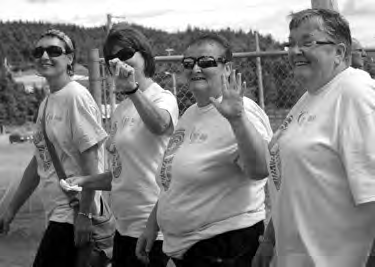100 Perks of Having Cancer: Plus 100 Health Tips for Surviving It (91 page)
Read 100 Perks of Having Cancer: Plus 100 Health Tips for Surviving It Online
Authors: Florence Strang
Tags: #Health; Fitness & Dieting, #Diseases & Physical Ailments, #Internal Medicine, #Oncology, #Cancer, #Medicine & Health Sciences, #Clinical, #Medical Books, #Alternative Medicine, #Medicine



Perk #91
Free T-Shirts
I
pulled out my T-shirt drawer one
evening and realized that it is prac tically
bursting at the seams. I am not normally
a T-shirt gal, so it took me by surprise that
I have accumulated so many of these
garments. As I rifled through the drawer,
I came to realize a perk: Many of these
T-shirts came to me FREE for participating
in cancer survivor events such as retreats,
the Relay for Life and the Run for the Cure.
In some cases, I got two T-shirts for the
same event: the standard white participant one and the coveted survivors
T-shirt (okay, maybe coveted is a bit strong of a word).
Although there is some controversy in the cancer world about the use
of the term
survivor
and what it means, there is no denying the special syn-
ergy that exists among the group who gets to wear the “coveted” T-shirt.
Having shared a similar experience, we feel an automatic kinship with
other survivors. (We also get to say,
Cancer . . . been there, done that, got
the T-shirt!
)
I am pretty sure that, as I walk or run the track wearing my survivors T-
shirt, spectators are looking at me and thinking,
Wow! Look at that cool yellow
T-shirt. All I got was a boring old white one. I wonder what I have to do to get to
wear the yellow one?
Well, probably they are not thinking that. But I am cer-
tain that at least some of the spectators are looking at me and thinking,
Wow! Look at my mom/sister/daughter/friend/girlfriend. She is a survivor!
Taking part in cancer survivor events can be a joyous experience. Allow
yourself to feel the special energy of being part of a survivors’ group.
I 383 J

384
100 Perks of Having Cancer
HEALTH TIP #91
Is There Joy in Soy?
T
he three things you should never discuss at a party are religion, politics,
and soy. People have very definite opinions about whether soy is a savior
or the devil. Sometimes those opinions are based on misinformation or old
information. Let’s start with the basics.
The basic whole form of soy, the soybean, is a legume. But the magical
thing about this legume is that it’s one of the few plants that contain the
kinds of proteins our bodies need to survive. The protein profile for soy-
beans is very similar to that of meat, milk, and egg protein, but it’s a plant.
It’s inexpensive to grow, and there’s a lot of it on our planet. Studies con-
tinue to show that eating regular servings of soy will help lower cholesterol
and reduce the incidence of heart disease.
So what’s the problem? One of the big problems with soy is that the
soy protein contains phytoestrogens or “plant estrogens.” Soy protein
doesn’t contain the female hormone estrogen, per se, but substances in the
soy protein called isoflavones act like estrogens to weakly activate estrogen
receptors. In the general population, and in women who have never had
cancer, this is actually a good thing because the weak estrogens can block
the more potent “natural” estrogens that your body produces from binding
with receptors and causing a chemical reaction that may decrease risk of
hormone-related cancer. The isoflavones may also help to eliminate trapped
estrogens in the fat tissue, which is another way to reduce cancer risk. Soy
also contains antioxidants and anti-inflammatory agents that can reduce
your risk of cancer in general. So when used in moderation and taken in
the right form, it can be a great part of a healthy diet.
But for those with hormone-related cancers like breast and endometrial
cancers, it would make sense that the action of the isoflavones activating
the receptors would put that population at an increased risk for cancer recur-
rence. Early animal studies confirmed this. For this reason, most oncologists
have told their patients with hormone-related cancers to steer clear of all
soy products.
Perk #91: Free T-Shirts
385
That belief is being challenged by a number of studies, the latest being
a 2012 study published in the
American Journal of Clinical Nutrition,
which
analyzed data from three separate studies that looked at the diets of over
9,000 women in America and China. They concluded that the data from
the studies show that for women who have had ER (estrogen-receptor) pos-
itive cancer, those who consumed 10 mg per day or more of soy isoflavones
had a 25 percent
lowered risk
of breast cancer recurrence. (Just for compar-
ison, three ounces of soymilk contains 10 mg of isoflavones and three grams
of total protein.) This result was not affected by taking the estrogen-blocking
drug Tamoxifen. ER negative women showed an even greater benefit with
a larger reduction in risk.
So just to recap: Women with a history of breast cancer ate soy and
reduced
their risk of getting cancer again. But before you go “tofu-loco” on
me, researchers caution that this study needs to be repeated and verified, as
it was a study that gathered its data from three other studies. More questions
are always raised with huge claims like this. One of the questions has to do
with the diets of the women as children. It is hypothesized that women who
grow up eating soy as children react differently to dietary soy than those to
whom soy is new. And the minimum amounts of soy protein were noted
to be no less than10 mg per day, but can you eat too much? And what kind
of soy protein were they eating? There are many different forms of soy:
whole, fermented, and processed.
Processing
is a broad term, but it really just means taking something
healthy and then grinding it, heating it, separating it by use of chemicals,
kicking the crap out of it, and turning it into another substance to be
used with other chemicals that will be sold to you as food. Since the
main attraction of soy is its protein, this is the part that manufacturers
use. The soybean can be put through a process that breaks it into parts
and isolates the soy proteins from the carbs and fats. These are called
soy
protein isolates
and they are chemically derived—that is, chemicals are
used to separate the different parts of the soy. You will find soy isolates
in breakfast bars, breads, energy bars, and many frozen foods. They are
hard to avoid in most packaged foods, and, if you start reading some of
the labels in your pantry right now, I think you’d be surprised where
they’re hiding. Bodybuilders use soy isolates in powdered form to make
386
100 Perks of Having Cancer
“high-protein shakes,” and they are widely used in high-calorie supple-
ment drinks. Anywhere manufacturers want to add protein to their prod-
uct, they add soy isolates.
Manufacturers can also “hydrolyze” the protein to make
hydrolyzed soy
protein,
which is very similar to harmful monosodium glutamate (MSG).
Again, using chemicals (hydrochloric acid, to be precise) to complete the
process, this substance is about as far from the soybean as you can get.
Hydrolyzed soy protein and soy isolates both contain glutamates. Gluta-
mates affect brain function and cause other neurological symptoms, and,
for this reason, glutamates like MSG, soy isolates, and hydrolyzed soy con-
tinue to be studied for safety. Soy can also be processed into pills. Supple-
ments in pill form contain extremely high levels of hormonelike isoflavones
and all populations, even those who have never had cancer, are generally
discouraged from taking them.
There are other soy foods that are highly processed as well. Soymilk,
tofu, and soy cheeses, while not processed to the extent of the soy proteins,
still may cause concern. Some state that processed raw soy foods like these
contain substances that can block proper vitamin absorption and actually
increase your risk for cancer. Only the fermented soy products like soybean
miso, tempeh, and natto are beneficial and safe and seemingly have no
harmful hormone effects. Fermenting uses the whole soybean and no chem-
icals for processing. The use of yeasts and fungus alters the protein over time
so it becomes healthier for you overall and much easier to digest.
Researchers are always studying the Asian diet because Asians are
among those with the lowest incidences of cancer. But when we look at
the typical Asian diet, they only eat one serving of soy products per day,
which adds up to about 30 mg of isoflavones. The type of soy is usually
fermented soy like in soybean miso (miso soup) or tempeh. If they eat
tofu, it is a small sliver in soup or small cubes in stir-fry. They don’t eat
massive “veggie soy burgers,” they don’t drink soymilk (they don’t drink
ANY milk actually), and they certainly don’t mix up powdered soy isolate
megapower shakes!
Aside from the hormone and processing issues, another consideration
is that soybeans used in making the soy isolates and proteins are all sprayed
to the max with pesticides and are GMOs, or genetically modified organ-
Perk #91: Free T-Shirts
387
isms. Genetic makeup of crops can be modified to make the plant grow
bigger, be more resistant to bacteria or viruses, or be resistant to insects. A
full 90 percent of all soy products used in the United States are GMOs.
(Soybeans were the first GMO mass-produced crop in the mid-1990s.)
GMO crops continue to remain under scrutiny for health concerns related
to “gene transfer.” When GMO foods are eaten, they are absorbed into the
gastro intestinal tract. If the food was genetically modified to be resistant
to bacteria, for example, that resistance could be transferred
to the cells in your GI tract. This could mean problems in
There’s lots of crap
your gut, as the human body relies on certain “good” bacteria
flying around about
to maintain balance in your digestive system. Even when you
